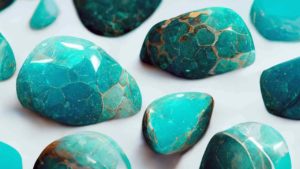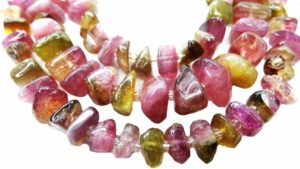Is shungite a gemstone?
Shungite is not a traditional gemstone, but it is a unique and relatively rare mineral that has gained popularity for its purported healing and protective properties. It is primarily composed of carbon and is found in the Shunga region of Russia, which is where its name originates.
Shungite is often used for making various products, including jewelry, sculptures, and pyramids. Its appearance is typically black, and it has a distinctive matte finish. Some people believe that shungite has metaphysical properties and can provide protection against electromagnetic radiation, purify water, and have healing effects, although scientific evidence for these claims is limited.
While it may not be classified as a traditional gemstone, it is valued for its unique properties and aesthetic qualities, making it a popular choice for certain types of jewelry and decorative items.
What is the shungite gemstone used for?
Shungite is used for various purposes due to its unique properties and potential metaphysical benefits. It is used to create jewelry items such as pendants, bracelets, and necklaces. People wear shungite jewelry for energy protection and balance.
It has the ability to absorb and neutralize electromagnetic radiation emitted by electronic devices like smartphones, Wi-Fi routers, and computers. Some people place shungite near these devices or wear it as a pendant to mitigate potential health concerns related to electromagnetic fields, EMFs.
In some alternative healing and spiritual practices, shungite is used for its healing and grounding properties. It may be used during meditation or energy healing sessions. Its unique appearance, with its deep black color and matte finish, makes it popular for crafting decorative items like spheres, pyramids, and sculptures.
What zodiac is shungite gemstone good for?
Shungite gemstone is not traditionally associated with specific zodiac signs in astrology, making it suitable for individuals of any sign. Its sought-after properties, like protection against electromagnetic radiation and potential healing abilities, can benefit anyone. People under signs like Aquarius and Gemini, who often use electronic devices, may appreciate its potential to mitigate electromagnetic field effects.
Is shungite gemstone a coal?
Shungite is a unique type of carbon-based mineral, and while it may resemble coal in appearance, it is distinct from ordinary coal. It is primarily composed of a form of carbon called fullerene, which is a molecule made up of carbon atoms arranged in a specific geometric shape. This is one of the reasons why shungite is distinct from coal. Coal is primarily composed of organic plant material that has undergone a process of carbonization.
It is found in certain regions of Russia, particularly in the Shunga village in Karelia. It has formed over billions of years from ancient organic material and sediments. Coal, on the other hand, is typically formed from the remains of plants that have been compressed and heated over millions of years. It is known for its unique properties, including its purported ability to absorb and neutralize electromagnetic radiation, as well as its use in alternative healing and spiritual practices. Coal does not possess these properties.
While the gemstone may share some superficial similarities with coal, it is a distinct mineral with unique properties and a different composition. It is not used as a source of fuel like coal, but is valued for its potential metaphysical and practical applications.

What is the benefit of shungite gemstone in rituals?
Shungite has several potential benefits in rituals and spiritual practices. It has purifying and cleansing properties. It is used in rituals to cleanse negative energies from spaces, objects, or individuals. It helps to remove stagnant or harmful energy, promoting a more positive atmosphere.
It is commonly used as a protective stone. It creates a shield against negative influences, including electromagnetic radiation and psychic attacks. People may carry this gemstone or place it in their homes to create a protective barrier. This gemstone is also associated with grounding and balancing energies. During rituals or meditation, it can help individuals connect with the Earth’s energy, promoting a sense of stability.
Many use the gemstone as an amplifier for their intentions during rituals or manifestation practices. It enhances one’s ability to focus and manifest their desires. Some individuals incorporate the gemstone in healing rituals, believing it can aid in physical and emotional healing. It may be placed on specific energy centers, such as chakras, or used in elixirs to promote well-being.
Which chakra is for shungite gemstone?
Shungite gemstone is associated with the root chakra and, to a lesser extent, the heart chakra in certain metaphysical and spiritual practices. The root chakra is located at the base of the spine and is associated with feelings of stability, security, and being grounded. The gemstone’s grounding and stabilizing properties align with and support the root chakra, helping individuals feel more rooted and secure.
While the gemstone is primarily linked to the root chakra, it can also be associated with the heart chakra, which is located in the chest area and relates to love, compassion, and emotional healing. Shungite’s energy can help open and activate the heart chakra, fostering emotional balance and healing.
Is shungite gemstone a yin or yang?
The energies of yin and yang represent opposing, but complementary forces that are fundamental to the balance and harmony of the universe. Yin is associated with qualities like darkness, passivity, receptivity, and femininity, while yang is associated with qualities like light, activity, assertiveness, and masculinity.
It can be seen as having properties that align more closely with yin characteristics. Its color, which is predominantly black, is often associated with yin energy. It is also known for its grounding and calming properties, which are in line with yin attributes. In metaphysical practices, It is often used to balance and harmonize energies, which aligns with the energies of yin and yang seeking equilibrium.
What is the age of shungite gemstone?
Shungite gemstone is one of the oldest minerals on Earth, with an estimated age of around 2 billion years. Its formation dates back to the Precambrian era when the Earth’s crust was still relatively young. It is primarily found in the Karelia region of Russia, specifically near Lake Onega and the Shunga village, where it was first discovered.
It has originated from ancient organic material, such as plankton and algae, which accumulated on the sea floor and underwent a unique transformation process over billions of years. This lengthy geological history contributes to the mineral’s unique properties and its reputation for having potential healing and protective qualities.
Can shungite gemstone get wet?
The gemstone is generally safe to get wet, but the extent to which it can be exposed to moisture depends on the specific type and quality of the gemstone. Most shungite can be rinsed or briefly soaked in water without any significant harm.
However, prolonged exposure to water or submersion may affect its appearance and durability over time, particularly for polished or coated shungite items. It’s advisable to pat dry or wipe the jewelry and objects after they come into contact with water to prevent potential degradation.
Is shungite a volcanic gemstone?
No, it is not a volcanic gemstone. It is a unique carbon-based mineral that is primarily found in the Karelia region of Russia, particularly near Lake Onega and the Shunga village. It has a different origin than volcanic gemstones. It has formed over billions of years from the remains of ancient organic material, such as plankton and algae, which accumulated on the sea floor and underwent a unique transformation process.
Volcanic gemstones, on the other hand, are formed through volcanic activity, where molten rock (magma) cools and solidifies to create gemstones like obsidian, peridot, or amethyst. Its formation is distinct from volcanic processes.
What is another name for shungite gemstone?
There isn’t another widely recognized name for this particular mineral. However, it’s worth noting that shungite can be classified into different types or grades based on its carbon content and appearance. The two main types of shungite gemstones are “regular shungite” and “elite shungite.” Elite shungite is often referred to as “noble” or “silver shungite” due to its higher carbon content and a distinctive silvery appearance when polished. These distinctions are based on shungite’s quality and appearance rather than alternative names for the mineral.
Is shungite gemstone flammable?
Shungite gemstone is generally not flammable under normal conditions. It is primarily composed of carbon, and while carbon can burn under certain circumstances, shungite itself is quite resistant to combustion. In fact, one of its unique properties is that it has a high carbon content and is often used for its potential to absorb and neutralize electromagnetic radiation.
However, it’s essential to keep in mind that the flammability of any material can depend on various factors, including its specific composition, size, and how it’s used. In its natural form, it is not considered a highly flammable material, and it is not typically used as a fuel source. Nonetheless, it’s important to exercise caution around any substance near an open flame or high heat, including shungite gemstone or shungite-containing products.
Is shungite gemstone a fossil?
No, the gemstone is not a fossil. While it does originate from ancient organic material, such as plankton and algae, it has undergone a unique transformation process over billions of years that has turned it into a distinct carbon-based mineral. Fossils are the preserved remains or traces of once-living organisms, and they typically retain the original structure and characteristics of those organisms.
Shungite, on the other hand, has experienced a complex geological transformation involving heat, pressure, and chemical changes that have resulted in its unique composition and properties. It is primarily composed of carbon and often contains fullerenes, a specific arrangement of carbon atoms. So, while this gemstone has organic origins, it is not considered a fossil, but rather a mineral with its own distinct properties and characteristics.
What is the difference between coal and shungite gemstone?
Coal and shungite gemstone are both carbon-based substances, but differ significantly in origin, composition, and properties. Coal is formed from the remains of ancient plants, subject to millions of years of heat and pressure. It is used as a fossil fuel.
Shungite gemstone, on the other hand, is a unique carbon mineral primarily found in Russia, originating from ancient organic material like plankton. It has a complex structure, often containing fullerenes. It is valued for its potential healing and protective properties, while coal is primarily used for energy production. In summary, the gemstone is a mineral with distinct properties with different uses, while coal is a fossil fuel.
Read next: Manifest Miracles with Lapis Lazuli: Your Ultimate Guide to Abundance!




